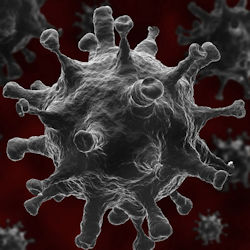Biological Agents
Coronavirus: Coronaviruses are a large family of viruses that can infect both animals and humans. They are named for their crown-like appearance under a microscope and can cause a wide range of illnesses, from mild respiratory infections to severe and sometimes fatal diseases.
While some infections may only result in mild symptoms, others, such as Severe Acute Respiratory Syndrome (SARS), Middle East Respiratory Syndrome (MERS), and COVID-19, have had significant global health impacts.
- SARS-CoV, the virus that caused severe acute respiratory syndrome (SARS), which was first identified in 2003
- MERS-CoV, the virus that caused Middle East respiratory syndrome (MERS), which was first identified in 2012
- SARS-CoV-2, the second strain of the coronavirus that causes COVID-19, which was first identified in 2019
Smallpox: Smallpox is a severe and sometimes fatal disease caused by the variola virus. It is unique to humans and has no known animal reservoirs.
Smallpox was one of the deadliest diseases in human history, spreading quickly from person to person through direct contact or contaminated materials. Although the disease was eradicated worldwide in 1980 through an extensive vaccination campaign, its potential use as a biological threat keeps it a subject of concern today. Because routine vaccination stopped decades ago, only a small portion of the population retains immunity, making awareness of the disease’s characteristics still important. For now, the key takeaway is that smallpox remains a theoretical risk due to bioterrorism or lab accidents.
Tularemia: Tularemia is also known as "rabbit fever" or "deer fly fever" is one of the most infectious diseases known. It is a rare but serious infectious disease caused by the bacterium Francisella tularensis. It can infect humans and animals, most commonly rabbits, hares, and rodents. People can become infected through insect bites, handling infected animals, breathing in contaminated dust, or consuming contaminated food or water. Because only a small number of bacteria are needed to cause illness, it poses a significant health risk in both natural settings and potential bioterrorism scenarios.
Viral Hemorrhagic Fevers (VHFs): VHFs are a group of illnesses caused by several distinct families of Filoviridae viruses, such as Zaire ebolavirus (EBOV), Marburg virus (MARV), Lassa virus (LASV), and Dengue virus (DENV). They represent some of the most dangerous infectious diseases known to humans because they damage the blood vessels, reduce the body’s ability to clot blood, and can lead to severe internal bleeding, organ failure, and death.
Because of their high fatality rates, severe symptoms, and potential to spread, the CDC has identified VHFs—along with smallpox, anthrax, plague, botulism, and tularemia—as possible biological weapons. While rare in the United States, outbreaks in other parts of the world highlight the importance of understanding these viruses, their transmission, and the protective measures needed to reduce the risk of exposure.
Knowledge Check Choose the best answer for the question.
4-4. How are viral hemorrhagic fevers (VHFs) especially dangerous to humans?
You forgot to answer the question!

